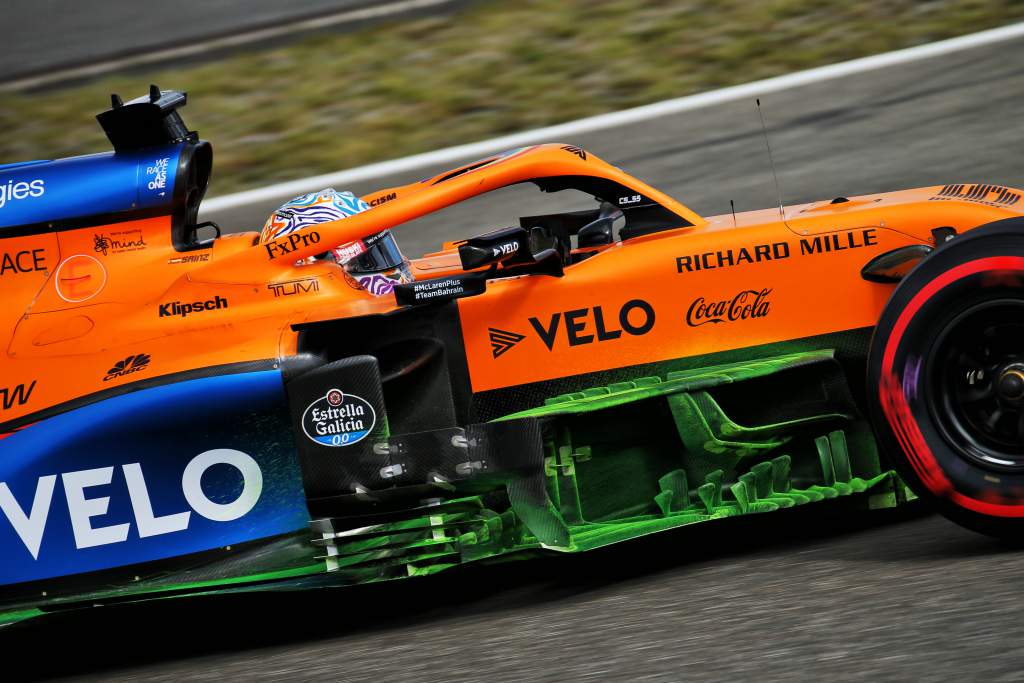Up Next

Formula 1 testing begins in Bahrain on Friday morning, and will bring an end to some teams being able to closely shield their designs during the launch season.
Last year’s top three teams Mercedes, Red Bull and McLaren have all gone out of their way – in different manners – to hide parts of their 2021 cars. Others across the grid have also kept some cards close to their chests.
With only three days of testing this year, the emphasis on performance evaluations will be bigger than ever. That means teams doing more running with what they intend to race with.
Here’s what Gary Anderson, Mark Hughes, Scott Mitchell and Edd Straw are hoping will be revealed over the coming days.
RED BULL’S REAR SUSPENSION
Red Bull has been the most secretive of all when it comes to what it’s shown of the car so far, with just two studio photos and a close crop of the driver released. While you might think you’ve seen it in action, the footage released came from running in the 2019 RB15.
So what’s Red Bull hiding? We know that it has focused its development token spend on the rear and it appears to have moved towards the Mercedes concept, but beyond that we’re light on detail.
Whether it’s just Red Bull being ultra-protective to avoid giving anything away or there’s genuinely something eye-catching hidden in this area will be made clear in testing.
For a team that has made a habit of starting relatively badly then coming on as the season progresses in recent years, it needs to go well straight out of the box.
So whatever has changed, Red Bull needs to run well right from the start of testing. If it does, perhaps the seemingly impossible dream of a two-team fight for the title might unexpectedly come true?
MERCEDES’ HIDDEN FLOOR
Mercedes was especially coy about its floor at the launch of its W12, to the extent that the launch car had just a featureless dummy flat section of outer floor.
From the way the sidepods have been narrowed it’s clear Mercedes has devoted a lot of attention to further energising the airflow along the car’s lower flanks in an attempt at clawing back the downforce lost to the new regulations.
The interaction between this flow and that through the underbody is fundamental to how effective a car is in generating efficient downforce.
The suspicion is that some sort of attempt has been made at inducing Coanda effect – whereby the airflow clings to the body surface as it makes its way down to the rear – but the precise contouring of the floor will be absolutely crucial in this endeavour.
THE EXTENT OF McLAREN’S BARGEBOARDS
McLaren went to some effort to hide its bargeboard package in the images released from its shakedown at Silverstone.
While The Race was able to get some idea of the design by using what visual data was available to an image of last year’s bargeboards, the fact McLaren has been so keen to hide that area suggests there could be something eye-catching on display in testing.
The bargeboards play a crucial role in feeding the airflow to the underfloor and while they don’t generate downforce in their own right, they are a critical area in terms of setting up the airflows needed to do so.
A theme of the launches has been the bargeboards – and to call them that is underselling the complexity of these complicated packages – becoming ever more intricate. In particular, horizontal louvers are proving popular.
While the regulations haven’t impacted this area directly, the different demands of the floor do play a part here. If McLaren has found a new way to optimise this area, that could offer it a significant advantage.
Whether there is something genuinely innovative here, or it’s simply another variation on the usual themes, will become clear once McLaren hits the track.
TOKEN SPENDS
In addition to secrecy around aerodynamic developments, we’ve had hints of token spends from every team (and Haas confirming it didn’t spend any) but many have curiously declined to share specifics.
Aston Martin and Alpine have disclosed the location of their spends, Williams has admitted to using one of its tokens last year and not spending the other, while Red Bull’s aforementioned rear suspension tweaks may well have necessitated a new gearbox.
But we don’t know, and the exposed nature of F1 testing is the first real opportunity to change that. We’ll also be able to judge whether this cloak-and-dagger approach has been worthwhile.
Aero secrecy makes sense because Mercedes, for example, has ensured that whatever it will have on the car in day one or two of testing has not already been snapped, replicated and produced in double-quick time. That slows down rivals who may try to play catch-up.
But on the token side it’s odd because the spends were locked in a long time ago and therefore replicating a new design isn’t possible. Perhaps it’s simply that old habits die hard.
ANY SURPRISES
Though teams are carrying over most of their cars from 2020, one of last year’s great innovations, Mercedes’ dual-axis steering system, will not be returning.
The DAS has been banned for 2021 and that’s nothing new – it’s been known for almost as long as the system’s existence has been public knowledge.
However, the return of pre-season testing marks the anniversary of this controversial, brilliant innovation being spotted for the first time – a reminder of F1 tech’s glory days where unexpected ideas were front and centre, and everyone got so excited about it.
We’d love a repeat this season. In truth, it’s difficult to see where that will come from given the carry-over and the token system.
But perhaps someone will surprise again, coming up with an unexpected or questionable innovation to tackle the reduced downforce at the rear of the car?



